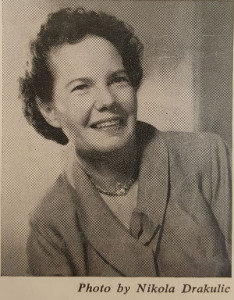The Doctor Who Dared: William Osler

Author:
Iris Noble ![]()
![]() Complete Authored Works
Complete Authored Works
Publication:
1959 by Julian Messner, Inc.
Genre:
Biography, Non-fiction
Series:
Messner Shelf of Biographies (World History)
Pages:
192
Current state:
This book has been evaluated and information added. It has not been read and content considerations may not be complete.
Book Guide
Search for this book used on:
One of the great medical men of America was Sir William Osler, foremost pathologist and leading diagnostician of his time. His greatness stemmed not alone from the impact of methods and ideas that influenced medical progress, but from the warmth of a personality that made him friend and father, guide and teacher, physician and philosopher to thousands of people. As chief physician, at the age of thirty-nine, and one of the "Big Four" of John Hopkins, he introduced revolutionary new techniques that have become standard practice throughout the world. His book, "The Principles and Practices of Medicine", became the Bible for doctors, brought him enduring fame and led to the formation of the mighty Rockefeller Institute of Medical Research. As a teacher he left a priceless legacy—the wise doctors of today.
Canadian born Osler had a reputation for playing pranks and was more mischievous than studious. However, at seventeen he became fascinated by biology and began keeping careful records of his research—a habit he instilled in all of his pupils. Inspired by a passion for healing, he attended McGill University and then spent two fabulous years abroad studying the methods of outstanding doctors. Specializing in pathology, he gradually gained a thorough understanding of more diseases than any doctor had ever achieved. When he returned to teach at McGill, he was the first to bring order out of the chaos of Montreal General Hospital. In those days nurses were often drunk derelicts and conditions were far from sanitary. Osler opened windows, painted walls, put space between beds, insisted on clean linens every day, defied tradition in every way to bring about reforms in hospital practices. He dared to bring medical students into hospital wards, not merely as observers but by having them take part in the diagnosis and treatment of patients. He dared to introduce the idea of resident doctors—revolutionary in the 1800's but accepted procedure today. Osler started reforms that resulted in medical miracles. Even before the discovery of the tubercle bacillus, he advanced the radical theory that tuberculosis was spread by contagion from one human being to another and was the first to isolate consumptive patients.
Captivated by the character and far-sightedness of the American people, he accepted an offer to teach at the University of Pennsylvania and his friendliness and understanding drew students to him. Here again he introduced new ideas and unconventional teaching methods, set up laboratories for demonstration teaching and revolutionized hospital techniques, medical practices, doctor training and attitudes toward the suffering. When he came to John Hopkins he achieved his ideal—finely equipped laboratories and freedom to train the most brilliant doctors in the nation.
He received the coveted Doctor of Sciences degree and accepted a Regius Professorship at Oxford University. He was knighted for his accomplishments but was more touched by student devotion than front-page acclaim.
Dr. Osler was a great humanitarian and despite his dedication to medicine, a profound believer in the humanities. In the annals of medical history no name is so revered as that of the great Osler, and in the warm and compelling portrait of a distinguished medical pioneer, Iris Noble again evidences her skill as biographer.
From the book
To view an example page please sign in.
To view awards and booklists please sign in.
Content Guide
Please sign in to access all of the topics associated with this book and view other books with the same topics.
Please sign in to access the locations this book takes place in and view other books in the same location.
Please sign in to access the time periods this book takes place in and view other books in the same time period.
For information about the lead characters please sign in.
Find This Book
Search for this book used on:


